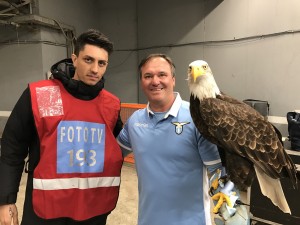Euroscena’s Manuel Lombardini discusses eagle-eyed OB operations at the Napoli-Real Madrid Champions League match

Manuel Lombardini from Euroscena with an eagle – a symbol of the Lazio soccer team! – and unnamed eagle trainer.
Manuel Lombardini, the 31-year-old technical manager of Euroscena, is describing the broadcast operations involved in the recent Napoli-Real Madrid Champions League match. “We followed the match at the San Paolo stadium in Naples on 7th March with two of our mobile control rooms – two outside broadcast units of different size and capacity, namely: OB22, which was responsible for creating the international host signal; and OB20, which followed the national integration for Mediaset, with a total of 25 TV cameras. Unit OB 22 is our top gallery, and as technical chief I decide the entire plan that deals with events like this.”
According to Lombardini, “the process is always the same: the customer passes us some information on the event, whilst Mediaset Premium deals with both the international feed and the national integration. On his request the coordinator decides which mobile unit to send according to the tech plan and the number of cameras required. Then we also decide which ‘extras’ are necessary to make the difference from venue to venue.”
In this instance three Grass Valley LDX86 SuperMotion cameras that create 3X images with 75 frames per second – three times more compared to the nominal speed – were provided in order to achieve fluidity in slow motion. Two of them were placed six metres away from every corner, away from the main grandstand, and the third was in the stands next to the main camera.
Lombardini adds: “The TV compound is very functional with 50 people engaged, and during the match some cameras of the national feed are shared and [utilised] for the international feed too. The two mobile production units are connected by optical fiber and no extra cable has been extended. The exclusive use of a mono nodal fiber in practice made it possible to transform everything into a single virtual control room.
“In practice, all of the signals captured by the mobile vehicles which are used to produce the national custom feed and all those of the van which shoots the international feed are interchangeable and ‘co-present’. During the proper game time, it is the international feed that uses some of the national feed resources.
“The same happened for replay systems: in fact, the EVS systems onboard both OBs, thanks to the total networking, are viewed by the operator as a single machine (though scattered on two OB vans) having 25 feeds available. [In addition] two other small cameras located physically at the top of each back-goal were used.”
Fiber connectivity
These broadcast class cameras were connected by fiber that carries the signal to the CCU on board. All other cameras were carrying the signals via triax, given that the stadiums are already pre-wired
Only the retro-goal cameras, the super slow-mo, the ultra motion and the netcam signals were relayed via optical fiber. The super slow-mo cameras can work with a normal phase at 25 fps or shoot up to six phases, as successfully demonstrated in May 2016 during the Champions League FInal in Milan with 46 cameras deployed.
The video mixers are also by Grass Valley, whilst other key equipment includes a BSE controllers, Stage Tec Aurus Platinum audio mixer, and Nexus matrix.
Also of note during the recent Real Madrid match were two goalline GLT Technology cameras to virtualise the images taken from the field and make it possible to determine whether the ball has gone into the goal or not. The subsequent transmission was complex and the signals were aired via fiber optic from the shelters of EITowers that are available in most of the stadiums in Italy.
Three feeds were produced: World Feed A (main and backup), Feed B Path 1 and Feed B Path 2, which differed substantially in the pre- and post-coverage. In practice, Euroscena creates eight chains that can be aired, plus a ninth which is the ‘1’ followed by UPS, for a total of nine on-air chains. Of these, the main and backup travel via fiber, then five chains are supplied via satellite uplink, whilst the direct Camera1 feed is useful in case of power crash or any other problem.
The international graphics contributions were received from Deltatre that produced them via a mobile vehicle on the spot and were only applied to certain feeds.
